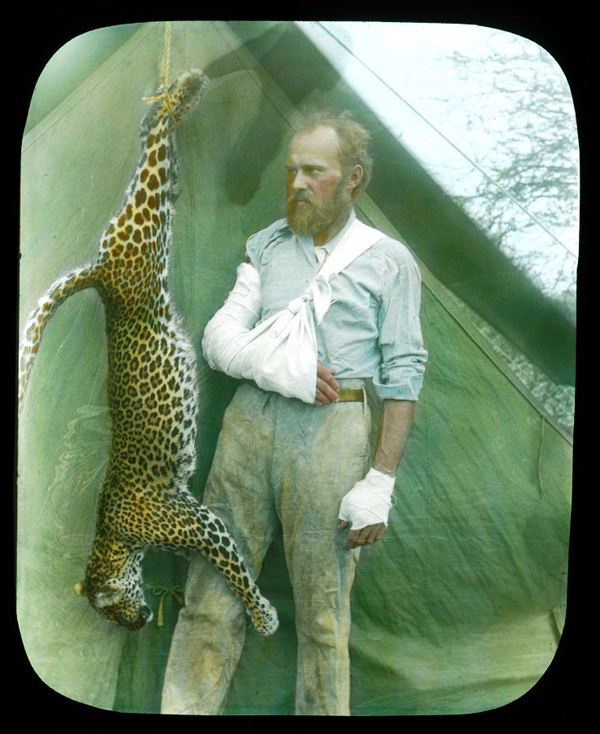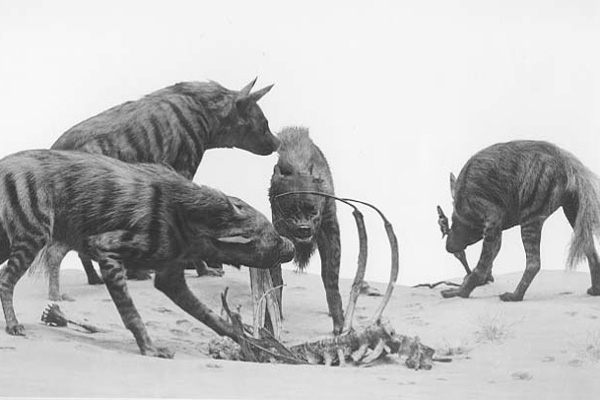For generations, a cackle of striped hyenas have been cornered in the Field Museum's Reptile Hall. Two bear their teeth at each other in an eternal fight over a rib cage of unknown origin, though it's been picked clean of meat; one strips a leg bone as it holds a hoof down with its paw; and a fourth observes the desperate scene with morose puppy-dog eyes.
Across the way, deer linger in Carl Akeley's lavish, exquisite Four Seasons diorama, "the Mona Lisa of Taxidermy." But the hyenas, another product of Akeley's hands, are tucked away on an anonymous patch of dirt with a couple sad patches of dead grass, surrounded by blank tan walls, devouring a bloodless skeleton. The scene is part storage locker, part post-apocalyptic nightmare.
But the Field Museum is trying to give them a proper habitat, and has so far completed one-third of its crowd-sourced fundraising goal of $170,000—with the aid of Chief Curiosity Correspondent and Akeley superfan Emily Graslie—to finally complete the last of the 20 dioramas in the Hall of Asian Mammals.

"I really like hyenas," says Sarah Crawford, an exhibit developer at the Field Museum. She's a liaison between the museum's curators and its builders, translating their current research and the museum's vast historical archives into physical form. "They're scrappy. They're survivors. They've survived all this time in this little corner of the museum. They've been orphaned. I want to give them a new home."
Crawford begins the diorama construction by generating lists, research, and questions for curators and scientists. "There's a creepy records room I like going to in the sub-sub basement," Crawford says. "It has archives for every single object that comes in. There's a folder that has articles that were published about it and field notes that were gathered." At the same time, Aaron Delehanty, who works in the museum's Fabrication Shop, gathers visual context from sources like Google Earth, archival photos, and the Munsell Soil Color Chart. An artist with an MFA in painting, Delehanty will also paint the backdrop for the hyena's habitat. (His last diorama backdrops, for the museum's China exhibit—"a nice test run," Crawford says—took 40 days of work.)
"Artistically I've been waiting for a job like this to come up," Delehanty says. "It's really the dioramas that brought me here." Delehanty's favorite diorama at the museum is one of cranes nesting in a colonial village; his personal work reflects an interest in the border between the natural and the urban. And that suggests one visual story the diorama could possibly tell: the "near-threatened" hyenas, less than 10,000 in number, are both threatened by peri-urban encroachment and adapting to it. Eventually the information gathered to create the diorama will be winnowed down to a narrative, which could place them in the habitat that they lost, or are losing, or it could be within the fringes of our habitat that they're trying to make their own.
Crawford's memories of the Field Museum's dioramas go back to childhood, driving in from Flint, Michigan. "It was the first time I'd seen dioramas," she says. "I was transfixed." For Delehanty, their power comes from not just the illusion they create of the natural world, but the illusion that the viewer is both present and invisible, observing species act and interact with other species without the observer effect or the species segregation of zoos.
"If you're doing it well," Delehanty says, "you're capable of disappearing into the diorama."



